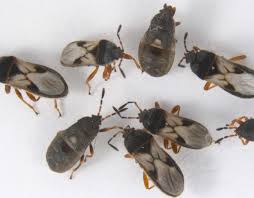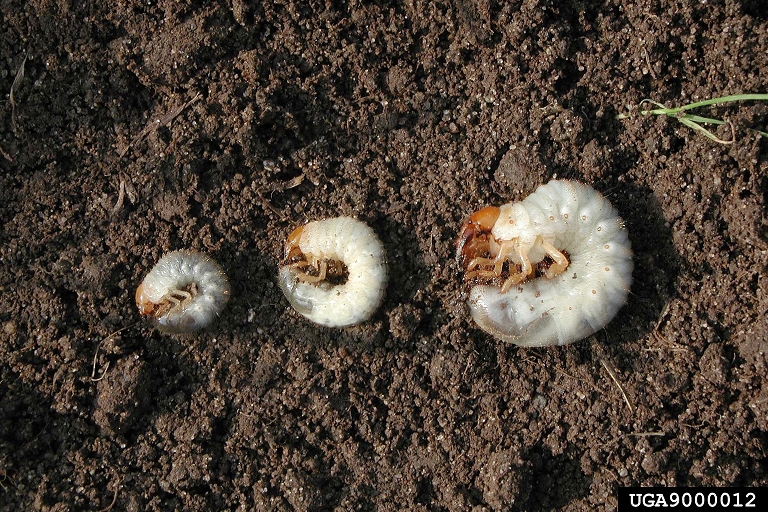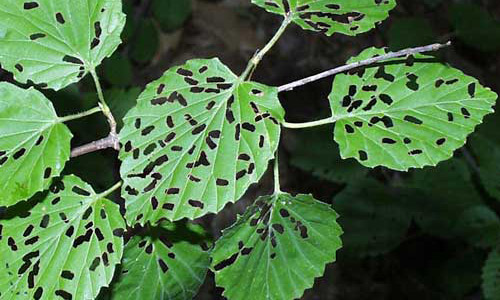The February 2015 meeting of the Garden Club of PEI featured Christine Noronha, Entomologist with Agriculture and Agri-Food Canada. She talked about the most common insect pests we encounter in our gardens.



Scarlet Lily Leaf Beetle appeared on PEI in 2004. It has since spread across the province. It is native to Europe and Asia. It was first seen in North America in Montreal in 1943, and has moved across eastern Canada and as far west as Alberta. It is thought to have spread through the importation of plant bulbs.
These beetles overwinter in the soil as adults. They emerge in early spring and lay about 450
eggs in batches of about 12 on the underside of leaves. The larvae feed under the leaves. They are reddish, but are identifiable as
black blobs, because they cover themselves in their own frass (excrement) which makes them unattractive to predators.
Mature larvae drop to the ground, burrow into the ground, and make a
cocoon. One generation per year is
produced.
Host plants:
mostly lilies. asiatics are most
susceptible. They also feed on
fritillaria, lily of the valley (convularia), flowering tobacco (nicotiana),
hollyhock, hosta, potato, and solomon’s seal (polygonatum).
To manage these pests:
·
hand pick adults and crush or drop them into a
container of soapy water. The soap will
prevent them from breathing.
·
spray with diluted neem oil. Neem degrades quickly in warm weather, and
must be reapplied at least every 5 to 7 days.
·
young larvae are more susceptible to
insecticides than adults. Spray the
underside of leaves where larvae feed.
·
floating row cover may be effective.
A parasitic wasp,
Tetrastichus setifer, lays its eggs in beetle larvae. When the eggs hatch, the wasp larvae eat the
beetle larvae from the inside. PEI has a
low number of species of naturally-occurring parasitic wasps (4) vs Ontario
(12).
According to http://lilybeetletracker.weebly.com/ this wasp was introduced in Ottawa in 2012 and a researcher at Carleton Univerisity wants to introduce the wasp to other areas across Canada. According to her studies, the wasp attacks only lily leaf beetles, and it survives the winter. Gardeners are welcome to sign up to introduce pupae and eggs to their gardens.
Aphids are soft-bodied, tiny, pear-shaped insects that can be brown, black, green, white, or grey. They can be identified by short tubes protruding from the base of the body, and a waxy or woolly coating.
Females produce live babies. They are like Russian dolls - one inside the
other. Babies are born already pregnant,
and the babies inside the babies are also already pregnant! For that reason, aphids reproduce very
quickly. The babies produced are
wingless, but if populations become too large and food becomes scarce, babies
are born with wings so that they can fly to a new food source. During the summer, all babies born are
female. In fall, both males and females
are born with wings. They mate and lay
eggs, which overwinter.
Aphids have mouthparts that pierce the stems of
plants to suck out plant juices. Because
they attack multiple plants, they can spread disease. This is a problem for commercial growers.
Aphids feed in large groups on the undersides of leaves. Predators include lady beetle larvae and adults and predatory wasps, which lay eggs inside the larvae. Spraying with insecticidal soap is effective, but you can also just spray with plain water to knock them off the plants.
Greenhouse growers use Aphidius colmani - one package per square metre. A BC company called Bug Factory sells these. This is not as effective in open areas.
Earwigs
– males have curved pincers, females have straight pincers. The females are very good mothers. They lay eggs in a nest in the ground and
feed and protect their young for several weeks until they are ready to leave the nest in early July.
Babies hatch looking like smaller adults – no larvae stage.
Earwigs are most active at night. In the late fall, their blood is replaced
with a substance that acts as antifreeze, and they are able to withstand the winter. Adults emerge in spring, lay eggs, tend their
young, and then die.
Management:
·
break up soil and expose eggs on surface
for predators.
·
rolled up newspapers or pieces of garden
hose will attract them during the day.
Shake the paper and hose into a bucket of soapy water.
Mites feed on the undersides of leaves. Females lay about 300 eggs on the branches or stems of their host plan and overwinter there. They hatch in early spring and begin feeding. They grow from egg to adult in just 5 days when it is warm, longer when is cool. Several generations are produced in one year.
Management:
·
bring in lady beetles, lacewings, or predatory
wasps. This works best in confined space
like a greenhouse
·
spray with insecticidal soap, neem, or a
registered insecticide. To be effective, there must be direct contact with the insect.
Thrips have lacy wings that look like feathers. There are 6 stages to the life cycle: egg, 2 larval stages, prepupal, pupal, adult. One generation takes one month to complete. They are poor fliers, and are carried by the wind. Thrip damage makes leaves appear brownor mottled silver, and dry rather than wilted. They feed on the underside of leaves.
Management: Biological
controls are not successful. Because
they feed on weeds, keep weeds controlled.
They also will attack stressed plants, so keep your plants well watered
and healthy.
 |
| damage from carrot rust fly larvae |
Management:
·
They are poor flyers, so putting up a
low barrier can deter them
·
cover with floating row cover
·
avoid bruising carrot leaves – they are
attracted to the scent
·
seed carrots later in the season to
avoid the larvae’s life cycle
·
harvest carrots before the second week
in September to avoid major damage
·
Resistafly is a variety of carrot seed
available at Vesseys.com. It’s leaves
have no scent, and does not attract carrot rust fly.
Cutworms overwinter as eggs, larvae, pupae and as adults. They feed by cutting young seedlings at their base. They are attracted to weedy areas.
Management:
·
cultivate soil to expose cutworms to
predators
·
planting late starves them
·
they are nocturnal – hand pick at night
·
put a collar of cardboard or foil around
each plant
·
ground beetles and birds are great
predators

Chinch
bugs
have sucking mouthparts that feed on grass blades and roots. Adults are black with white spots and white
wings. The nymph is bright red with white bands across the back.They are attracted to poorly
tended lawns and compacted soils with lots of thatch buildup and lack of
moisture.
Management:
·
aerate and remove thatch from lawns
·
use slow-release fertilizer and lime
·
keep lawn moist
·
do not cut lawn too short, which
stresses the plants
June
beetles have a 3-year life cycle. Grubs eat grass roots. In June, adults lay their eggs in the soil. They hatch in 2 weeks.
 |
| from left: larva of Japanese beetle, European chafer, and June beetle |
Management:
- a healthy lawn is the best protection against grubs
- skunks and crows are dig up the lawn to feed on grubs
- parasitic nematodes will control them – need the right kind, and the soil must be moist to be effective
Japanese beetles have invaded PEI in the last 4 years. There is a huge population in the Charlottetown, Cornwall, Canoe Cove area. They attack trees such as crab apple, elm, maples, but mostly concentrate on roses. The beetles are very beautiful, with iridescent bodies, but very destructive. The larvae are in the ground where they attack roots. The adults can skeletonize leaves very quickly. They overwinter as grubs that are smaller than June beetles.
Management:
·
hand pick and knock into jar of soapy
water
·
insecticidal soap must make direct
contact with beetle
·
pheramone use: be cautious, because this attracts more to
your area
·
check soil in late summer: more than 12 grubs per square feet means you
need to treat the lawn
Colorado Potato Beetle attacks potatoes, tomatoes. The yellow eggs are laid on the underside of leaves. The young and the adults feed on leaves. The young shed their skin 4 times as they grow (instars) and overwinter in the ground.
Management:
·
hand pick and knock into jar of soapy
water
·
kill eggs by crushing
·
Bacillus
thurengis may work on larvae
Striped Cucumber Beetle overwinters as an adult. It lays eggs in the soil. Adults eat leaves, pollen, and flowers of cucumber plants. The larvae eat the roots and stems. It can spread bacterial disease, which appears as bacterial wilt. Infected plants cannot be saved.

Sawflies – Rose Slug look like tiny caterpillars. When you disturb the larvae, they raise their back end, which caterpillars do not do. Adults lay eggs on leaves, and the larvae eat all spring and summer, skeletonizing the leaves. Host plants include roses, raspberries, ash, elm, dogwood, willow. They are hard to remove from the plant because they are on the undersides of leaves.
 |
| damage from viburnum leaf beetle |
Viburnum leaf beetle is greyish-brown. The yellow and black larvae eat holes in viburnum leaves, leaving only the large veins behind. To check for an infestation, check stems of plants. Rows of bumps mean there are eggs buried in the stem.
Management:
·
They are too numerous to hand pick.
·
In fall when leaves have fallen, cut off
infected stems
·
Spray insecticide when larvae are young
Brown marmorated stink bug, an insect not previously seen on our continent,
was accidentally introduced into Pennsylvania. It was first collected in 1998.
Adults are approximately 17 mm long and are
shades of brown on both the upper and lower body surfaces. They have the typical “shield” shape of other
stink bugs, almost as wide as they are long. To distinguish them from other
stink bugs, look for lighter bands on the antennae and darker bands on the
membranous, overlapping part at the rear of the front pair of wings. They have
patches of coppery or bluish-metallic rounded depressions on the head.
The name “stink bug” refers to the scent glands
located on the dorsal surface of the abdomen and the underside of the thorax.
It releases a bad odour if crushed.
In its native range, it feeds on a wide variety
of plants, including apples, peaches, figs, mulberries, citrus fruits and
persimmons. This true bug has also been reported on many ornamental plants,
weeds, soybeans and beans for human consumption. Feeding on fruits such as
apple results in a characteristic distortion referred to as “cat facing,” that
causes the fruit to be unmarketable.
These bugs are a big problem in the US and have
been found in the Niagara region of Ontario, where they are a major threat to fruit
production. They were spread by hitching
rides on Home Depot trucks moving goods from the US to Ontario, and have been
found on trucks on PEI as well. These
bugs even survive going through the washing machine.
If you find this bug on PEI, please catch it in
an escape-resistant container and bring it to Christine Noronha at the Agriculture
and Agri-Food Canada building on University Avenue in Charlottetown, or call her at
902-394-1350.
